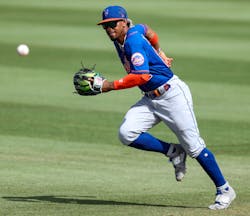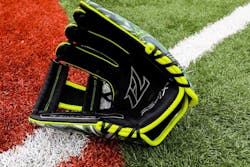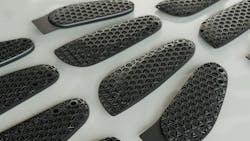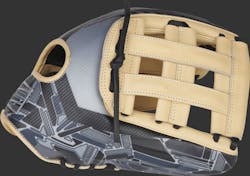Engineers at the Rawlings Sporting Goods Co., an iconic U.S. manufacturer of sports equipment founded in 1887, were tasked with coming up with an upgraded version of the company’s baseball glove to make it more effective for ballplayers. They also wanted to use the best of the newer manufacturing processes and design tools on the market to make that glove.
To that end Rawlings teamed with Fast Radius, a manufacturing company, and Carbon, a 3D printing firm, to develop Rawling’s recent release: the REV1X glove. It comes with innovative 3D-printed lattice inserts and other performance enhancing features designed and developed used cloud-based technologies.
“We already make extremely high-quality gloves, but we never want to get complacent,” says Robert Newman a glove engineer at Rawlings. “So, we developed the REV1X as a way to keep striving and improving every individual glove component.”
The new glove is also poised to help Rawlings maintain and expand its share of the market for baseball gloves. That market, by the way, was about $134 million in 2021, though industry watchers expect that to bounce back to exceed $150 million, where it was prior to the COVID-19 pandemic.
Goals for the Glove
Rawlings engineers wanted the final glove to be better for players in terms of protecting them and helping them catch hard hit and thrown balls, and then quickly digging the ball out (often without looking) to get it back into play. If the player’s gloved hand can sense where the ball is, it’s much easier for them to blindly grab it with their throwing hand.
They team also wanted to make the gloves more “playable” than current gloves.
“We define playability as a term that refers to ‘break-in time,’” says Newman. “It basically refers to how soon a player can realistically use the glove in a game after they first get it. It is determined for each player by several variables, including the size and shape of their catching hand and how they snap the glove closed.
“But we have developed internal standards that let us quantify what percentage of the break-in process will need to be done by the player who will be using it,” he continues. “For example, softer gloves will be 80% broke in at the factory and 20% by the player before he uses it in an actual game.”
The less flexible or stiffer a glove is, the more time players will need to get it comfortably “broken-in.” And every player has own definition of when a glove is “broken-in,” so a perfect standard that applies to everyone is impossible.
Glove Innovations
One of the most notable new features on the REV1X are the 3D-printed insets for the thumb and pinky finger it uses instead of the more conventional padding found on other gloves. The idea of changing and stiffening the thumb and pinky reinforcements made a lot of sense and was suggested to Rawlings by Francisco Lindor, a New York Mets shortstop with several Gold Glove Awards.
“The inserts give the glove stiffness and integrity and are not necessarily for protection or a better fit,” says Newman. “Traditional gloves have thin polyethylene inserts wrapped in felt and wool and sewn into the glove.”
“The new latticed inserts are made of FPU 50, a flexible polyurethane, that provides all the desired mechanical responses and can be used as a 3D feedstock,” explains Daniel Baker, manager of manufacturing engineering at Fast Radius. “It is a semi-rigid material with the impact and fatigue resistances needed the in highly variable sporting environment. And 3D printed unlocks limitless possibilities for REV1X gloves, from designing the lattice itself to changing the glove’s fit, feel and performance. And it opens the door to the possibility of more easily customizing gloves for specific players.
The new inserts are lightweight and flexible without sacrificing protection or durability. They also streamline the look of the glove. Better still, they don’t wear out as easily as traditional materials while providing unmatched playability and ball handling. The inserts are designed to last the life of the glove and cannot be removed and replaced. They are inserts that must be attached rather than made as integral parts of the glove due to constraints of the 3D printing process.
The inserts are made using Carbon’s Digital Light Synthesis (DLS) process.
“Carbon DLS uses programmable liquid resins with light projection to rapidly turn out parts,” says Baker. “It lets the design team create lattice geometries that were lighter and more functional than standard foam. Lattices can also take almost any shape or density, which unlocks tremendous design potential. In fact, the sky’s the limit with the DLS printing process. It can accelerate development parts with a range of unconventional materials and design freedoms not been seen before in the baseball industry.”
Newman at Rawling concurs, adding: “The materials of other 3D printing processes are fairly limited. They are generally extremely rigid without much give. Carbon’s process can use flexible materials, like the FPU 50 polyurethane, or semi-rigid ones—not just ABS or metals.”
Fast Radius also had the infrastructure, software, and expert technicians to make these inserts. They let the team quickly go from prototyping to production, making enough gloves so that baseball players anywhere—from MLB to high-school ball fields—get their hands on the latest baseball equipment.
Other features include:
- Reduction and elimination of the laces commonly used on the palm and web. This creates a smoother, seamless path for caught balls to predictably roll down from the webbing and into the player’s waiting throwing hand.
- An adaptive wrist opening let players adjust it to the size of their hands and wrists. Wrist openings on traditional gloves are fixed.
- Multi-layered back-finger layups make the glove flexible and let it retain its other properties over the life of the glove, making it more durable and consistent. Traditional leather gussets on the back finger lets the glove become more flexible as gets broken it in, but it continues to wear and becomes even more flexible than the player might like; it is inconsistent over time.
The Market
Field tests of the new glove have been successful, and the company has made plans for rolling it out.
“The company is selling four models of the glove,” says Newman. “Two for the infield, two for infielders, one for outfielder and another for the pitcher. And there could eventually be others.”
The target market is any competitive baseball player, from travel ball to the pros. The REV1X costs almost $400. The average glove bought by targeted users is $260 to $360, and a custom glove ranges from $360 to $460.
The Evolution of the Baseball Glove
1860-1875: Players on professional teams were injuring their hands trying to catch hard-hit line drives and grounders. To protect their hands, a few started wearing gloves on their catching hands, akin to the ones railroad brakemen wore. A player on the Cincinnati Red Stockings took to wearing a buckskin mitten after hurting his hand. Another player went with a flesh-colored glove to hide the fact he was wearing one (a supposed sign of weakness or unmanliness at the time).
1890: Most players were wearing some sort of glove to prevent injuries, and at least one firm—Draper & Maynard—began making padded gloves for ball players.
1919: Rawlings, a glove manufacturer, took an idea from St. Louis pitcher Bill Doak to replace the webbing between the thumb and index finger with a several straps to create a “pocket.” It made it easier and less painful to field a ball. It was the first time the gloves were modified to make them more potent tools for playing baseball rather than just protection and cushioning from fast, incoming balls. It eventually became the official glove of major league baseball.
1922: Wilson developed a mitt made for catchers, a prototype for all future catcher’s mitts.
1957: Wilson came out its A2000, which had a deeper pocket and a U-shaped heel. The company also cut the glove’s weight, making it 5 to 10 oz. lighter than any other. The glove was also durable, breathable and had built-in foam-like padding. It quickly became the MLB’s official glove. Some baseball enthusiasts credit the glove improvements that arose at this time for making it much more difficult for hitters to rack up hitting averages over .400.
New glove designs and features are constantly being tried. Some sports equipment companies are even looking at replacing leather, a traditional material which has been used for at last 100 years, with synthetics. But synthetics have several drawbacks. For one, they never get more flexible than when they are brand-new; they don‘t “break in.” Stiff gloves are more difficult to close on caught balls. In addition to remaining stiff, plastics remain slick throughout their lives. And being slick means balls can more easily slide out of the pocket. Synthetics also have a shorter life than leather, and gloves made from them rarely last an entire season.
But is inevitable that sport equipment companies will continue to innovate, especially with materials, now that so many man-made fibers and fabrics are available.
One innovation is the design and proliferation of position-specific gloves. For example:
Outfielder’s gloves are longer than any other player’s to give them more range when tracking down fly balls. For example, the gloves let players snag balls before just going sailing over the home-run fence. The gloves also have deeper pockets to stop balls from dropping free once caught.
Pitcher’s gloves have a closed web that hides the ball and hand grip from the batter.
Catcher’s mitts are more padded and larger than other gloves. They provide more protection against fast-thrown pitches and gives pitchers a larger target to throw at. Catcher gloves also have a curved edge useful for scooping up balls in the dirt.
First baseman’s gloves are larger than other infield gloves. Like the catcher’s glove it gives other infielders a larger target to throw at.
Infielders’ gloves worn by the rest of the team are small and light, letting them move their catching hands as quickly as possible. Second basemen usually have the smallest glove. This lets them quickly grab the ball from the mitt and fire it to first base for a double play. Shortstop and third basemen, meanwhile, have longer gloves to increase their fielding range. The third basemen gloves often also have deeper pockets to help grab hard-hit balls closer to home plate than the other infielders.






